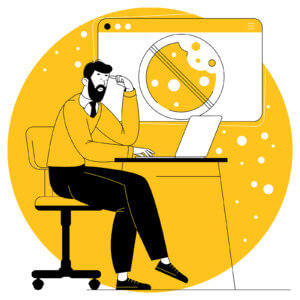October 5, 2021

The odds are that you’ve heard that third-party cookies are going away. But you’re probably wondering what exactly that means to you as a marketer and how it will affect your work moving forward.
If you are not familiar with the term, third-party cookies are tracking codes that are placed on a web visitor’s computer after visiting a website. When that same web visitor visits your site or any other, the third-party cookie tracks all of their activity (which sites they visit, what products they click on, etc.) and sends it back to whoever created the cookie. Many brands use cookies on their sites so they can serve up ads to their web visitors on other sites.
If you’re an advertiser, third-party cookie data gives you insights about your web visitor’s overall online behaviors, such as websites they frequently visit, search history, device details, purchases and interests that they’ve shown on various websites. With this detailed data, you can build detailed prospect profiles to decide which of your visitors are your best potential customers and worthy of investing ad dollars to connect with them.
You can then create a re-targeting list that can be used to send ads to your past visitors or people with similar web profiles, called lookalike audiences.
For many years, third-party data has been integral to how advertisers decide where to place their ads and what messages should be served up to specific groups.
As an internet user and consumer, you’ve experienced this marketing tactic many times.
A Google blog post announced the 2022 target date for the final removal of third-party cookies and explained that the reason for the change was to protect users and their privacy.
“Users are demanding greater privacy – including transparency, choice, and control over how their data is used – and it’s clear the web ecosystem needs to evolve to meet these increasing demands,” the post stated.
Safari and Firefox have both blocked third-party cookies since 2013. Google has been working with advertisers for the last two years to ensure that this shift doesn’t destroy the online advertising industry, but the change is coming quickly now.
If your current practice is to simply track your website’s visitors’ behaviors, preferences and basic demographics while they’re on your website and only while they’re on your site, nothing much will change.
However, if you’re a marketer that relies on robust third-party data for targeting online advertising or a very specific audience-targeting strategy, you’re going to have to change your ways.
We’ve known for decades that when we get something for free on the internet, we are the product. So it shouldn’t surprise anyone that social media sites like Facebook and search engines like Google already have substantial amounts of information that they could use to develop detailed profiles using a single cookie.
There may come a time when, as marketers, we subscribe to a data source that is powered by one or multiple of these entities to get the same kind of aggregate information we can get today from third-party cookies.
In a cookie-less world, to identify and access external audiences, we may need to subscribe to one or more of these big-box data sources to get insights about our potential customers. The data sources will be able to track and monitor behaviors but in an aggregate way. Hopefully, this will protect everyone’s individual privacy and give marketers a way to access insights that will be valuable.
All of this does not mean online advertising is dead. We’re just going to need to find different ways to build an audience and learn more about them. In next week’s column, we’ll explore some tactics that are worthy of consideration as we adapt to this new chapter of marketing.
This was originally published in the Des Moines Business Record, as one of Drew’s weekly columns.
More










